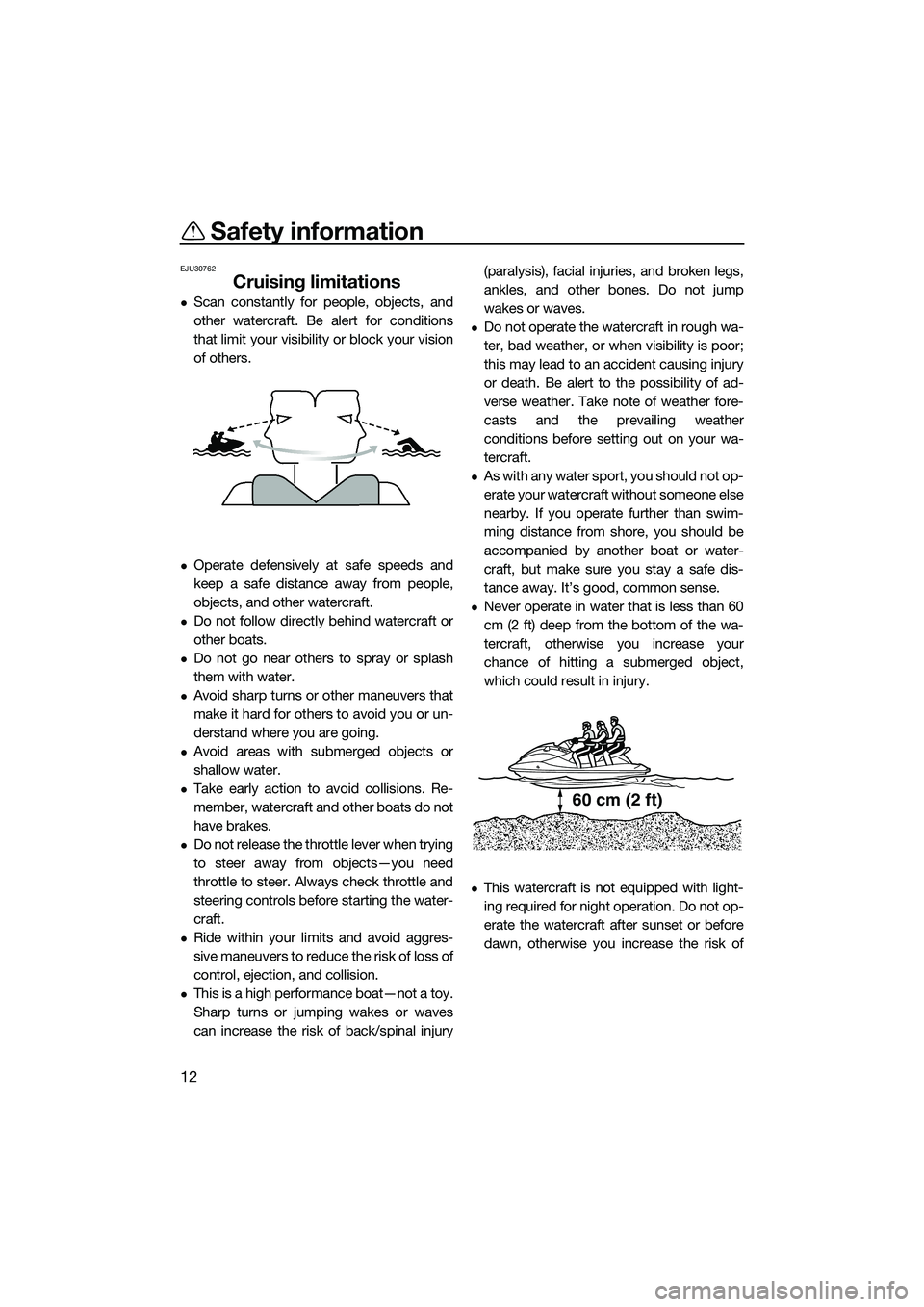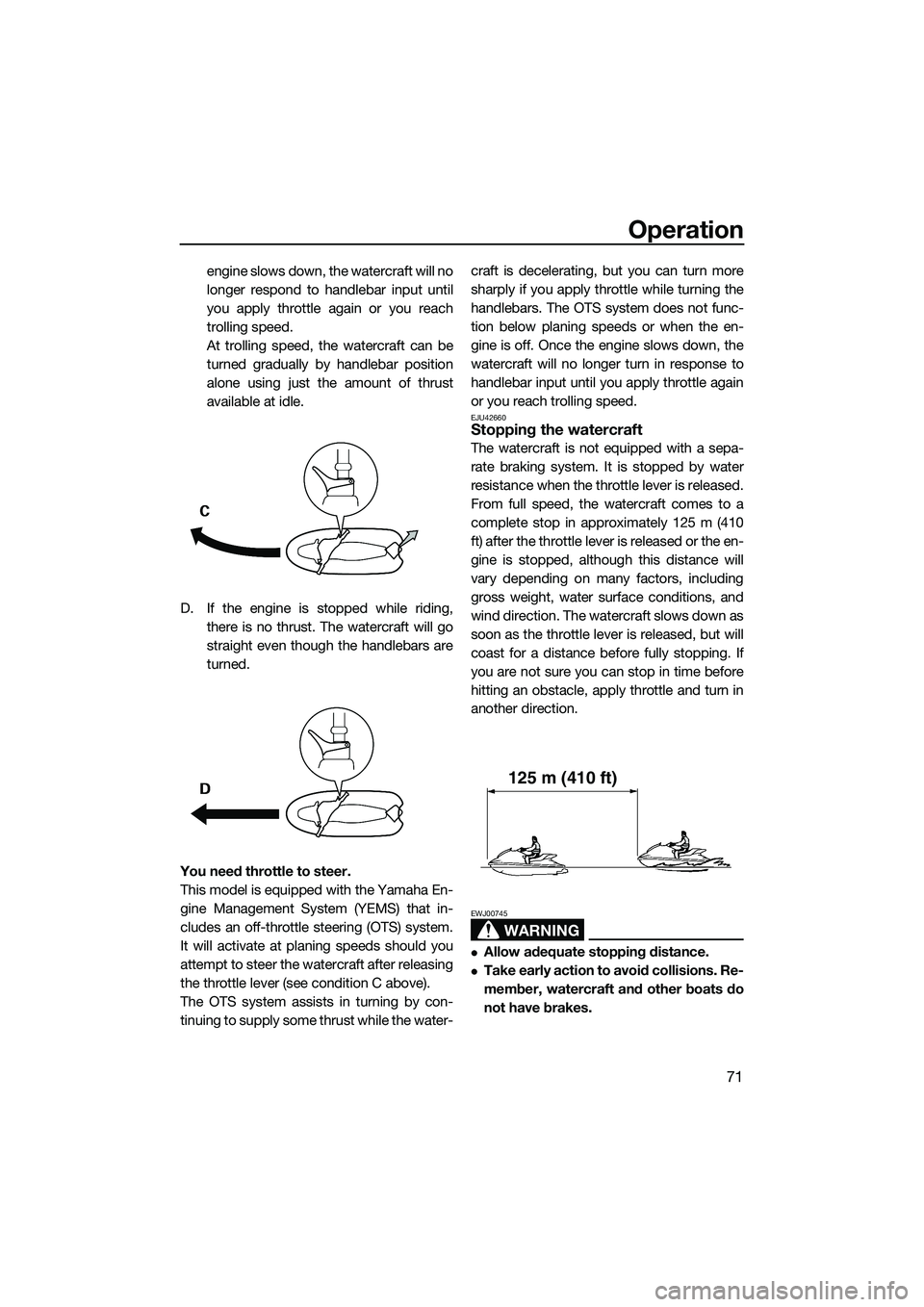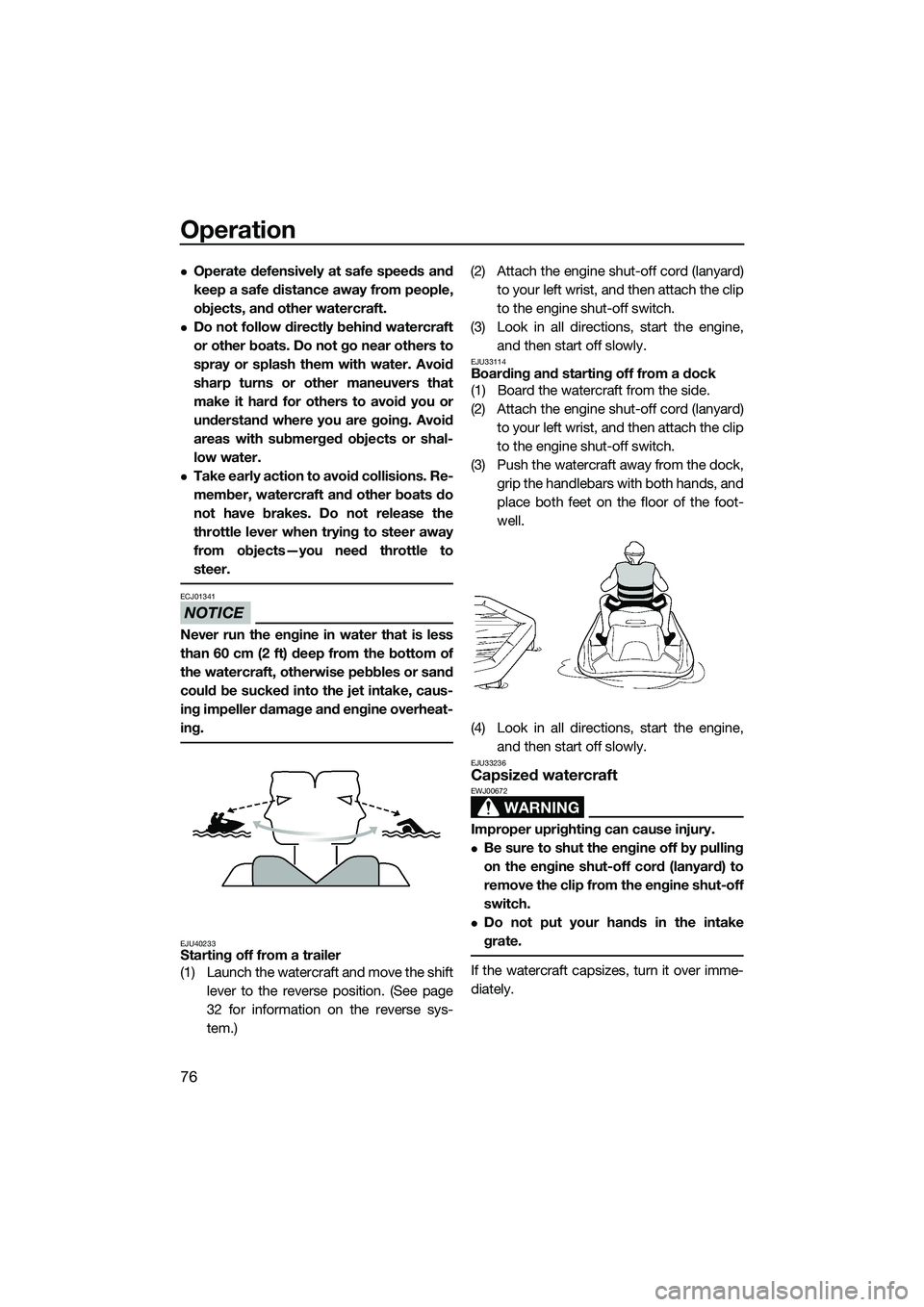brake YAMAHA FZS SVHO 2014 Owners Manual
[x] Cancel search | Manufacturer: YAMAHA, Model Year: 2014, Model line: FZS SVHO, Model: YAMAHA FZS SVHO 2014Pages: 108, PDF Size: 5.47 MB
Page 18 of 108

Safety information
12
EJU30762
Cruising limitations
Scan constantly for people, objects, and
other watercraft. Be alert for conditions
that limit your visibility or block your vision
of others.
Operate defensively at safe speeds and
keep a safe distance away from people,
objects, and other watercraft.
Do not follow directly behind watercraft or
other boats.
Do not go near others to spray or splash
them with water.
Avoid sharp turns or other maneuvers that
make it hard for others to avoid you or un-
derstand where you are going.
Avoid areas with submerged objects or
shallow water.
Take early action to avoid collisions. Re-
member, watercraft and other boats do not
have brakes.
Do not release the throttle lever when trying
to steer away from objects—you need
throttle to steer. Always check throttle and
steering controls before starting the water-
craft.
Ride within your limits and avoid aggres-
sive maneuvers to reduce the risk of loss of
control, ejection, and collision.
This is a high performance boat—not a toy.
Sharp turns or jumping wakes or waves
can increase the risk of back/spinal injury(paralysis), facial injuries, and broken legs,
ankles, and other bones. Do not jump
wakes or waves.
Do not operate the watercraft in rough wa-
ter, bad weather, or when visibility is poor;
this may lead to an accident causing injury
or death. Be alert to the possibility of ad-
verse weather. Take note of weather fore-
casts and the prevailing weather
conditions before setting out on your wa-
tercraft.
As with any water sport, you should not op-
erate your watercraft without someone else
nearby. If you operate further than swim-
ming distance from shore, you should be
accompanied by another boat or water-
craft, but make sure you stay a safe dis-
tance away. It’s good, common sense.
Never operate in water that is less than 60
cm (2 ft) deep from the bottom of the wa-
tercraft, otherwise you increase your
chance of hitting a submerged object,
which could result in injury.
This watercraft is not equipped with light-
ing required for night operation. Do not op-
erate the watercraft after sunset or before
dawn, otherwise you increase the risk of
60 cm (2 ft)
UF3K70E0.book Page 12 Tuesday, November 5, 2013 8:44 AM
Page 77 of 108

Operation
71
engine slows down, the watercraft will no
longer respond to handlebar input until
you apply throttle again or you reach
trolling speed.
At trolling speed, the watercraft can be
turned gradually by handlebar position
alone using just the amount of thrust
available at idle.
D. If the engine is stopped while riding, there is no thrust. The watercraft will go
straight even though the handlebars are
turned.
You need throttle to steer.
This model is equipped with the Yamaha En-
gine Management System (YEMS) that in-
cludes an off-throttle steering (OTS) system.
It will activate at planing speeds should you
attempt to steer the watercraft after releasing
the throttle lever (see condition C above).
The OTS system assists in turning by con-
tinuing to supply some thrust while the water- craft is decelerating, but you can turn more
sharply if you apply throttle while turning the
handlebars. The OTS system does not func-
tion below planing speeds or when the en-
gine is off. Once the engine slows down, the
watercraft will no longer turn in response to
handlebar input until you apply throttle again
or you reach trolling speed.
EJU42660Stopping the watercraft
The watercraft is not equipped with a sepa-
rate braking system. It is stopped by water
resistance when the throttle lever is released.
From full speed, the watercraft comes to a
complete stop in approximately 125 m (410
ft) after the throttle lever is released or the en-
gine is stopped, although this distance will
vary depending on many factors, including
gross weight, water surface conditions, and
wind direction. The watercraft slows down as
soon as the throttle lever is released, but will
coast for a distance before fully stopping. If
you are not sure you can stop in time before
hitting an obstacle, apply throttle and turn in
another direction.
WARNING
EWJ00745
Allow adequate stopping distance.
Take early action to avoid collisions. Re-
member, watercraft and other boats do
not have brakes.
125 m (410 ft)
UF3K70E0.book Page 71 Tuesday, November 5, 2013 8:44 AM
Page 82 of 108

Operation
76
Operate defensively at safe speeds and
keep a safe distance away from people,
objects, and other watercraft.
Do not follow directly behind watercraft
or other boats. Do not go near others to
spray or splash them with water. Avoid
sharp turns or other maneuvers that
make it hard for others to avoid you or
understand where you are going. Avoid
areas with submerged objects or shal-
low water.
Take early action to avoid collisions. Re-
member, watercraft and other boats do
not have brakes. Do not release the
throttle lever when trying to steer away
from objects—you need throttle to
steer.
NOTICE
ECJ01341
Never run the engine in water that is less
than 60 cm (2 ft) deep from the bottom of
the watercraft, otherwise pebbles or sand
could be sucked into the jet intake, caus-
ing impeller damage and engine overheat-
ing.
EJU40233Starting off from a trailer
(1) Launch the watercraft and move the shiftlever to the reverse position. (See page
32 for information on the reverse sys-
tem.) (2) Attach the engine shut-off cord (lanyard)
to your left wrist, and then attach the clip
to the engine shut-off switch.
(3) Look in all directions, start the engine, and then start off slowly.
EJU33114Boarding and starting off from a dock
(1) Board the watercraft from the side.
(2) Attach the engine shut-off cord (lanyard)to your left wrist, and then attach the clip
to the engine shut-off switch.
(3) Push the watercraft away from the dock, grip the handlebars with both hands, and
place both feet on the floor of the foot-
well.
(4) Look in all directions, start the engine, and then start off slowly.
EJU33236Capsized watercraft
WARNING
EWJ00672
Improper uprighting can cause injury.
Be sure to shut the engine off by pulling
on the engine shut-off cord (lanyard) to
remove the clip from the engine shut-off
switch.
Do not put your hands in the intake
grate.
If the watercraft capsizes, turn it over imme-
diately.
UF3K70E0.book Page 76 Tuesday, November 5, 2013 8:44 AM